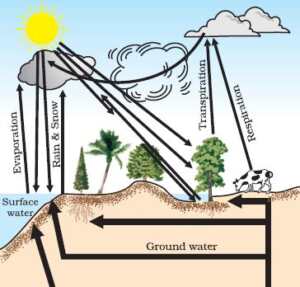Natural Resources MCQ Objective Questions Class 9 Science Chapter 14
1. The only planet that contains living organisms is:
- a. Mars.
- b. Uranus.
- c. The earth.
- d. Mercury.
2. 3/4th of our earth contains:
- a. Land.
- b. Water.
- c. Metals.
- d. Non-metals.
3. The planet that contains an atmosphere is:
- a. Mars.
- b. Uranus.
- c. The earth.
- d. All.
4. Our atmosphere is a mixture of gases. The gas with the highest percentage in the air is:
- a. Nitrogen.
- b. Oxygen.
- c. Carbon dioxide.
- d. water vapors.
5. Percentage of nitrogen in the air is around 78%, but the percentage of oxygen is only:
- a. 55%.
- b. 28%.
- c. 21%.
- d. 11%.
6. The atmosphere of Mars and Venus mainly consist of _ _ _ _ gas.
- a. Nitrogen.
- b. Oxygen.
- c. Carbon dioxide.
- d. water vapors.
7. The percentage of carbon dioxide in our atmosphere is.
- a. 0.01%.
- b. 0.03%.
- c. 1%.
- d. 3%.
8. The major source of carbon dioxide in our atmosphere is:
- a. Breakdown of glucose by the organism.
- b. Combustion of fuel.
- c. Both.
- d. none.
9. Plants are the biggest fixer of atmospheric carbon dioxide. Other processes/es that also fixes the atmospheric carbon dioxide is:
- a. The reaction of carbon with oxygen.
- b. The reaction of rock with C0 2 to form carbonates.
- c. Use of carbonate in some sea animals to make shells.
- d. b and c together fix the atmospheric C0 2.
10. The atmosphere on earth keep the earth surface temperature:
- a. High.
- b. Low.
- c. Fairly steady.
- d. none.
11. Moon does not have an atmosphere. As a result, its daily surface temperature _ _ _ _ _.
- a. Fluctuates heavily.
- b. Does not Fluctuates.
- c. Can’t say.
- d. none.
12. Cold winds from seas move toward the low-pressure areas due to:
- a. Convection.
- b. Conduction.
- c. Radiation.
- d. None.
13. Clouds and humidity do not let the radiation escape. The Desert does not have clouds. As a result:
- a. Days and nights both are hot.
- b. Days are hot and nights are chilly.
- c. Days and nights both are chilly.
- d. None.
14. Clouds are formed by the:
- a. Evaporation of water bodies.
- b. Condensation of water bodies.
- c. Conduction of heat in water bodies
- d. None.
15. Rain is formed due to:
- a. Condensation of cloud vapors.
- b. Conduction of cloud vapors.
- c. Movement of winds.
- d. None.
16. City of clouds is:
- a. Delhi.
- b. Bangalore.
- c. Cherrapunji.
- d. Mangalore.
17. Acid rains forms by the reaction of water with oxides of:
- a. Nitrogen.
- b. Sulfur.
- c. both.
- d. None.
18. Oxides of nitrogen and sulfur are produced by:
- a. Combustion of fossil fuels.
- b. Combustion of biogas.
- c. Buring of petrol.
- d. None.
19. Smog consists of :
- a. Unburnt carbon particles.
- b. Water vapor.
- c. both.
- d. None.
20. Which region has more biodiversity :
- a. A region having scanty rainfall.
- b. A region having abundant rainfall.
- c. Arid region.
- d. None.
21. Following regions are areas with high biodiversity :
- a. The Western Ghats.
- b. Sundarbans delta.
- c. both.
- d. None.
22. Biological magnification is the _ _ _ _ in the concentration of heavy metals and harmful compounds with successive trophic level:
- a. Increment.
- b. Decrement.
- c. None.
23. The concentration of heavy metals and DDT in the body is measured in:
- a. Moles/liter (M).
- b. kG/body weight.
- c. Parts per million (PPM).
- d. None.
24. Formation of soil from rocks takes place by the process called:
- a. Withering.
- b. Tearing.
- c. Carbonification.
- d. Ecological succession.


- a. Evaporation of water bodies.
- b. Transpiration in plants
- c. Respiration in animals.
- d. All.
26. A plant that fixes atmospheric nitrogen is :
- a. Leguminous plants.
- b. Cruciferous plants.
- c. Coniferous forests.
- d. None.
27. Scientists have discovered holes in the ozone layer of which region?
- a. The Arctic.
- b. The Antarctic.
- c. The Equator.
- d. None.
- Diversity in Living Organisms MCQ.
- Tissues Class 9 MCQ
- The Fundamental Unit of Life MCQ
- Why do we fall ill MCQ
Answer:
| 1.c | 11.a | 21.c |
| 2.b | 12.a | 22.a |
| 3.d | 13.b | 23.c |
| 4.a | 14.a | 24.a |
| 5.c | 15.a | 25.d |
| 6.c | 16.c | 26.a |
| 7.a | 17.c | 27.b |
| 8.c | 18.a | |
| 9.d | 19.c | |
| 10.c | 20.b |
Natural Resources MCQ Objective Questions Class 9 Science Chapter 14
Ref: Chapter 15, NCERT.
Very good
Janani